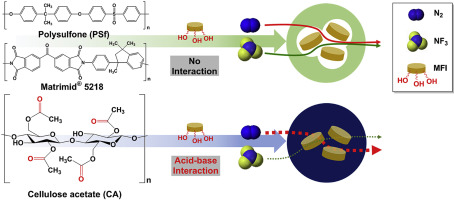Microporous and Mesoporous Materials ( IF 4.8 ) Pub Date : 2018-01-09 , DOI: 10.1016/j.micromeso.2018.01.006 Sunghwan Park , Eunhee Jang , Heseong An , Wansuk Choi , Jeong-Hoon Kim , Jung-Hyun Lee , Jungkyu Choi , Jong Suk Lee

|
A zeolite-containing mixed matrix membrane (MMM) is an attractive option to overcome the performance limits of polymeric membranes for large-scale gas separations. The poor interfacial adhesion between zeolites and polymers, however, should be addressed to realize the excellent separation performance of zeolites on large industrial scale. Herein, the interfacial void-free MMMs with incorporation of intact MFI type zeolite particles were successfully prepared by applying the Lifshitz-van der Waals acid-base theory for the selection of the appropriate polymer matrix. Our simple, but systematic approach was based on the adhesion force between MFI particles and a surrounding polymer matrix. The relatively high Lewis basicity of cellulose acetate (CA) leads to highest adhesion force with MFI particles among the tested polymer matrices, suppressing interfacial void formation. In addition, a careful analysis revealed that any residual surfactants on the surface of MFI particles are detrimental to fabricate interfacial void-free MMMs. Single gas (i.e. N2 and NF3) transport in the CA/MFI MMMs were characterized by changing the concentration of MFI particles up to 30 wt%. N2 permeability of CA/MFI MMMs was improved by as much as 304% compared to that of bare CA membranes with maintaining N2/NF3 permselectivity. Furthermore, gas transports in CA/MFI MMMs by varying the size of MFI particles from 0.2 through 0.6 up to 1.5 μm were analyzed by using the Lewis-Nielsen model. Our systematic theory-based guidance can be utilized to offer the appropriate polymer candidates for the zeolite-containing MMMs for high performance gas separations.
中文翻译:

Lifshitz-van der Waals酸碱理论协助制造用于气体分离的含MFI的混合基质膜
含沸石的混合基质膜(MMM)是克服聚合物膜用于大规模气体分离的性能限制的有吸引力的选择。然而,应当解决沸石与聚合物之间不良的界面粘合性,以实现在大规模工业规模上优异的沸石分离性能。本文中,通过应用Lifshitz-van der Waals酸碱理论成功选择了合适的聚合物基质,成功制备了结合了完整MFI型沸石颗粒的界面无孔MMM。我们简单但系统的方法是基于MFI颗粒与周围的聚合物基体之间的粘附力。醋酸纤维素(CA)的路易斯碱相对较高,导致在测试的聚合物基质中与MFI颗粒的附着力最高,抑制界面空隙的形成。此外,仔细的分析表明,MFI颗粒表面上残留的任何表面活性剂都不利于制造无空隙的MMM。单一气体(即NCA / MFI中的2和NF 3)传输MMM的特征是将MFI颗粒的浓度更改为最多30 wt%。与裸CA膜相比,CA / MFI MMM的N 2渗透率提高了304%,并保持了N 2 / NF 3的选择性。此外,在CA / MFI的MMM的气体运输通过从0.2 0.6通过高达1.5 MFI不同颗粒的大小 μ米通过使用路易斯-尼尔森模型进行分析。我们基于理论的系统指导可用于为含沸石的MMM提供合适的聚合物候选物,以实现高性能气体分离。











































 京公网安备 11010802027423号
京公网安备 11010802027423号